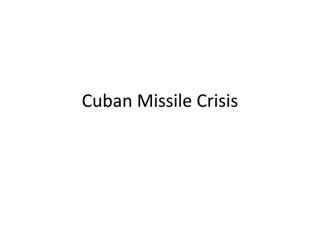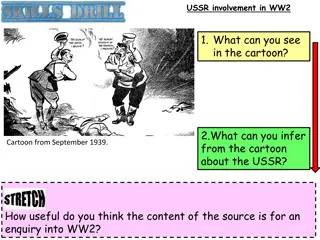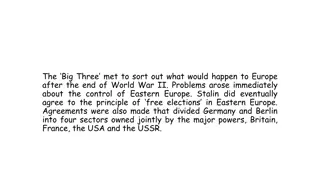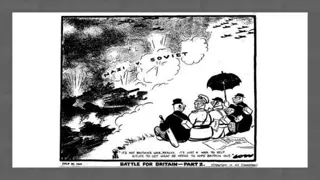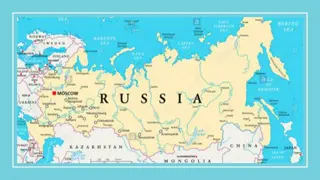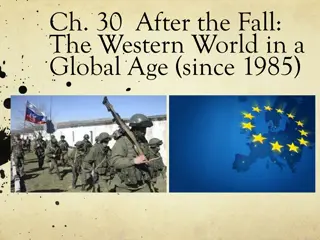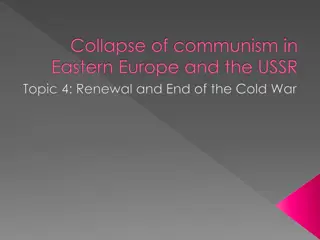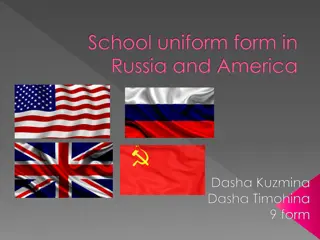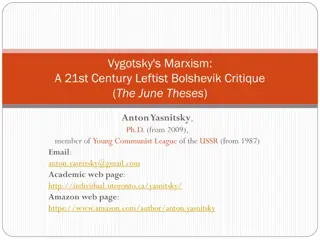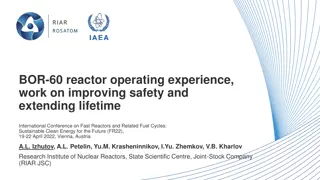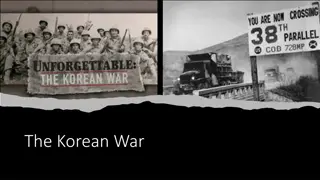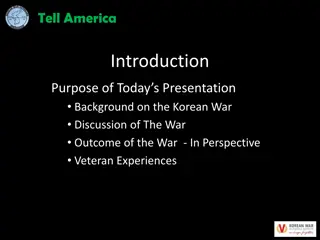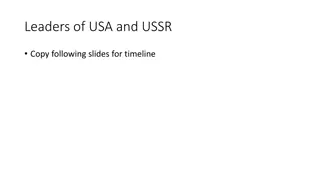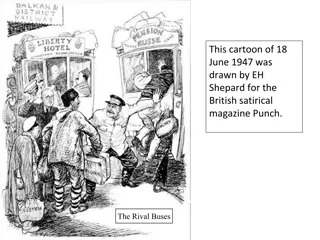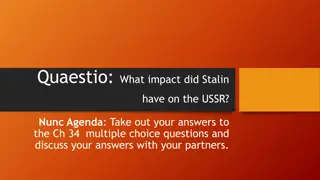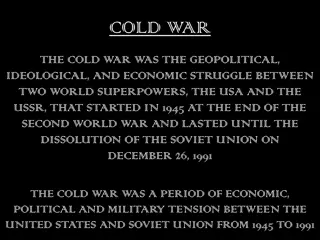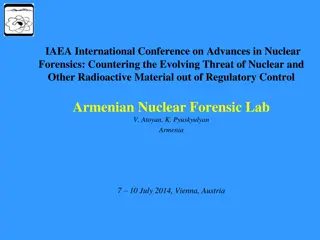Understanding the Cuban Missile Crisis in Historical Context
Explore various aspects of the Cuban Missile Crisis, including the political cartoons, Kennedy's response, USA's reactions to the Cuban Revolution, USSR's involvement in Cuba, and the outcomes of the crisis. Learn about the key players, their decisions, and the impact on Cuba, USA, and the USSR.
2 views • 37 slides
The USSR and Nazi Germany: The Pact of 1939
In the lead-up to WWII, the USSR signed a non-aggression pact with Nazi Germany, shocking the world. This pact included secret clauses dividing Poland and avoiding conflict for ten years. The USSR's alliance with Germany was a strategic move by Stalin due to fear of invasion and perceived weakness o
0 views • 13 slides
Post-World War II Division and Cold War Tensions in Europe
Big Three leaders post-World War II agreement on Eastern Europe control, division of Germany, Truman confronting Stalin, atomic bombings, USSR's influence in Eastern Bloc, Truman Doctrine against communism, US financial aid to combat communism in Europe.
5 views • 26 slides
World War II in Europe: The Invasion of the USSR and American Involvement
Hitler's plans to invade the USSR starting in 1940, the invasion through the Balkans, Operation Barbarossa in 1941, the challenges faced by German troops, the siege of Leningrad, the US providing aid to its allies, and the Atlantic Charter amid German submarine attacks.
0 views • 7 slides
The Ruthless Reign of Joseph Stalin in the Soviet Union
Joseph Stalin rose to power in the USSR after Lenin's death, implementing totalitarian control through purges, collectivization, and propaganda. His regime led to millions of deaths, forced labor camps, and a cult of personality, shaping Soviet society through fear and oppression.
0 views • 8 slides
The Fall of the Soviet Union: Gorbachev's Reforms and Global Impact
In the late 20th century, the collapse of the Soviet Union under Gorbachev's leadership ushered in a new era of economic, political, and social change. Gorbachev's policies of glasnost and perestroika opened up Soviet society, leading to nationalist movements and ultimately the dissolution of the US
0 views • 12 slides
Fall of Communism in Eastern Europe and the USSR: Renewal and End of the Cold War
The dissolution of the Soviet Union in December 1991 marked the end of an era, with the Revolution of 1989 seeing Soviet states revolt, culminating in the fall of the Berlin Wall symbolizing the collapse of Communism. Gorbachev's resignation on December 25th, 1991, swiftly followed by the dissolutio
0 views • 8 slides
Origins of the Cold War: Yalta and Potsdam Conferences 1945
The Cold War's origins stem from the tensions and suspicions between the USSR and the West post-World War II, highlighted through conferences like Yalta and Potsdam. At the Yalta Conference, held in February 1945, crucial decisions were made regarding Germany, Poland, and the UN. The Potsdam Confere
0 views • 10 slides
Evolution of School Uniforms: A Comparison Across Countries
The emergence, history, and current status of school uniforms in Russia, America, the USSR, and Britain are explored. From the abolition of mandatory uniforms in Russian schools to the diverse rules for attire in American institutions, the evolution of school uniforms reflects societal norms and edu
0 views • 10 slides
Vygotsky's Marxism in the 21st Century: A Critical Analysis by Anton Yasnitsky, Ph.D.
Anton Yasnitsky, Ph.D., a member of the Young Communist League of the USSR, presents a critical analysis of Vygotsky's Marxism in the 21st century. The three-volume research project explores Vygotsky's legacy and impact on psychology, challenging existing interpretations and offering new insights. T
0 views • 37 slides
BOR-60 Reactor Operating Experience and Design Configuration
The BOR-60 reactor, a key component of sustainable clean energy, has a rich history since its construction in the USSR. Its design configuration includes various components such as coolant inlet nozzles, control rod mechanisms, and fuel loading ducts. The core arrangement consists of control rods an
0 views • 12 slides
The Korean War: Causes, Participants and Consequences
The Korean War began after Japan's defeat in WWII when the country was divided at the 38th parallel. It started as a conflict between North Korea, supported by the USSR, and South Korea, backed by the U.S. The war ended in a stalemate with an armistice, leaving North Korea communist and isolated, wh
0 views • 5 slides
Overview of the Korean War: Background, Discussion, and Outcome
This presentation delves into the background of the Korean War, highlighting the historical context from the Korean Peninsula's division after World War II to the outbreak of the conflict in 1950. It discusses the involvement of North and South Korea, as well as key players like the United States, t
0 views • 15 slides
Leadership Timeline: USA and USSR Leaders
Explore the timeline of leaders from the United States and the Soviet Union, showcasing significant figures such as Harry Truman, John F. Kennedy, Richard Nixon, Joseph Stalin, Nikita Khrushchev, and more. Witness the transitions in leadership that occurred during critical periods in history.
0 views • 8 slides
Analysis of EH Shepard's 1947 Cartoon on US-USSR Influence in Eastern Europe
British satirical magazine Punch published a cartoon by EH Shepard on 18th June 1947 depicting the US and USSR as rival bus drivers competing for control and influence in Eastern Europe post-World War II. The cartoon symbolizes the struggle for power and alliances in the region, with Hungary and Bul
0 views • 10 slides
Impact of Stalin on the USSR: Totalitarianism, Five-Year Plans, and the Great Purge
Stalin's rule in the USSR brought about significant changes through totalitarianism, economic central planning with Five-Year Plans, and brutal measures like collectivization and the Great Purge, resulting in widespread suffering and loss of life.
0 views • 12 slides
The Cold War: A Geopolitical Struggle Between Superpowers
The Cold War was a significant period of tension between the USA and USSR from 1945 to 1991, marked by ideological differences, fear of attacks, and military posturing. Key events such as the Yalta Conference, formation of the United Nations, and strategies like the Truman Doctrine and Marshall Plan
0 views • 10 slides
Challenges and Solutions in Protecting Radioactive Sources in Post-USSR Armenia
The collapse of the USSR presented Armenia with challenges in managing radioactive materials due to limited resources and unclear responsibilities. Incidents of illicit trafficking of radioactive sources have been reported, highlighting the need for robust regulatory controls and forensic capabiliti
0 views • 20 slides
